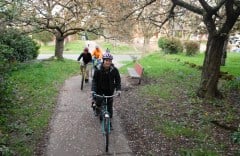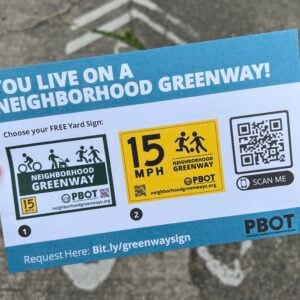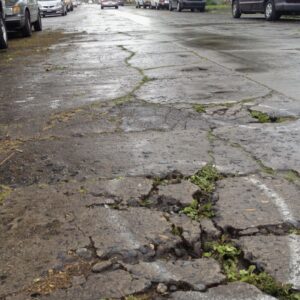
(Photos © J. Maus)
The City of Portland recently unveiled “neighborhood greenways” as a term to replace bike boulevards. At the monthly meeting of the City’s Bicycle Advisory Committee last night PBOT traffic safety staffer Greg Raisman showed up to explain more about their thinking behind the new name.
The main reason for the change is to better reflect what these projects are all about. PBOT realizes that by calling them “bike boulevards,” some Portlanders instantly bristle and come to project open houses armed for battle against them. PBOT hopes the new name won’t elicit such a negative reaction to the non-biking public.
“We envision that a Greenway hierarchy would serve a similar transportation planning framework as our general street classification system”
— Greg Raisman, PBOT
Our story about the name change showed a mixed reaction from readers. Several people were glad — saying it better reflects that the projects are about much more than just bikes. But many commenters were not happy with the name. Some said it was just marketing-speak, one person said it’s too “sneaky” and others thought it might lead to confusion and/or were skeptical it would work to alleviate the public’s misunderstanding of the projects.
But Greg Raisman from PBOT says the name change is about more than just semantics. While explaining the basic idea that “the name bike boulevard doesn’t capture the totality of what they do,” he also said it is in line with PBOT’s focus on livability:
“I’m also excited because it [the new name] puts the neighborhood front and center. Making our neighborhoods better, through the Portland Plan, we’re going to have a conversation about what that means.”

what PBOT is talking about.
This conversation, according to Raisman, will move PBOT from merely talking about transportation to a more concerted focus on “placemaking and community building.” One way to do that is by making more green spaces on our streets. Raisman says PBOT is working with Friends of Trees to place new street trees along entire routes of new neighborhood greenway projects. On one project in the works, there’s an idea to extend a park completely across the existing street (NE Holman) and maintain a cut-through only for bikes.
And neighborhood greenways might be just the beginning. In an email about the greenway hierarchy effort, Raisman wrote that PBOT is working with staff from the Portland Plan to identify a hierarchy of greenways similar to what currently exists for streets:
“We envision that a Greenway hierarchy would serve a similar transportation planning framework as our general street classification system. So, there may be one type of Greenway defined for residential streets, one for commercial streets, and one for separated pathways. The concept could move us beyond the “complete street” and into the “complete transportation system”.
In addition to more street trees and integrating “pocket parks” into street designs, Raisman says they hope the Portland Plan includes policy framework to make other placemaking elements like art, decorative planters more common throughout the city.
Learn more about PBOT’s bike boulevard neighborhood greenway projects on their website.





Jonathan, the Holman pocket park extension allows bikes AND PEDESTRIANS through . . . yet more evidence of why the name change is wise.
Possibly misposted…but relevant. One very easy thought which would require little money or political will would be to place stop signs at certain intersections along bike boulevards, now greenways. The stop signs would be for low traffic cross streets intersecting greenways. For example, The NE Tillamook-Hancock bike boulevard has several intersections without stop or yield signs in the 40s and 50s blocks. Place stop signs for the numbered blocks, excluding 57th, 45th, 28th, 21st, 15th, 7th, etc. This would increase safety and livability. Its easy, cheap, and requires little political will.
Greg, are you looking for a pilot project area? We’ve got a ton of unimproved streets in Brentwood Darlington that are ready to be turned into greenways, and lots of people who would be happy to see it happen here.
There’s no existing pavement to get in the way, and many of those streets are seldom used by cars right now (but are great for pedestrians, since the nearby paved streets don’t necessarily come with sidewalks).
“On one project in the works, there’s an idea to extend a park completely across the existing street (NE Holman) and maintain a cut-through only for bikes.”
Anyone ride east/ west through Dekum, Holman, or Ainsworth?
We need folks to come out to the next Holman Green Street PBOT meeting Tuesday May 4th from 6-8pm to show support for the project. The meeting will be at Concordia University 2811 NE Holman.
Dont listen to martha R. brentwood darlington is a trap. Especially henry street.
Martha R brings up a good point. Portland has many unimproved streets, or right of ways, that could be improved for better bike and pedestrian traffic. So instead of turning paved streets into greenways, the city could turn unimproved streets into greenways.
Other ideas.
The city should consider reducing budgets for neighborhood streets and focus dollars on arterials.
Neighborhood associations may be interested in funding and participating in greenway projects. Especially if the city cuts neighborhood street budgets.
They were lying then or they are lying now. Which is it?
The City of Milwaukie was ahead of the game on this one – from the Milwaukie Transportation System Plan:
“Designating a street as a ‘bike boulevard’ does not suggest that only bicyclists should use it. In fact, the treatments applied to bike boulevards make these routes safer for pedestrians and motorists as well, and the general traffic calming adds to neighborhood livability. With that in mind, using alternative labels for ‘bike boulevards’ might be appropriate to stress the multimodal benefit. Suggestions include “community corridors” and ‘neighborhood parkways.'”
Portland has been a pathfinder, and Portland’s example (and to some extent the controversies generated by it) has been very helpful to subsequent community attempts to implement concepts.
Camp Bike Fun (#4) – Ainsworth would be a GREAT place for a fully-separated bike path down the center of the greenspace – especially given the volume of bike traffic in that corridor.
I like the new name “neighborhood greenways” a lot. It ties in so nicely with a lot of what BES is doing on the bike boulevard network (bioswales on Ankeny & Clay St bike blvds et al).
More importantly, I think it will encourage people to view bicycle boulevards in a different, more positive light. Removing the words “bike” specifically from the title diffuses a lot of negativity from the less-bike centric. I mean, you might not bike, but regardless, who *wouldn’t* want calmer, more pleasant greener streets that you can walk, and jog on safely too?
(As a side note: the running community in Portland is HUGE! Absolutely HUGE! I would say, ten times more people run on Portland’s streets daily, than ride bicycles. I think it would be awesome to get the running community on board for developing future bike boulevards (sorry, neighborhood greenways!), because quieter, traffic calmed neighborhood streets would benefit walkers and runners so much as well as cyclists. I mean, look at Sunday Parkways! Millions of runners came out of the woodwork, and that demographic is exactly what Portland needs to give political and community support to foster the growth of bike blvds.
I wonder how this partnership could be fostered? Does the WPC represent runners too? Portland’s runners are just so strong in number, it seems like a big way to boost support for new traffic calmed streets, that isn’t really being taken advantage of…)
At any rate, traffic safety has consistently been Portland’s #1 concern in just about every survey ever taken (above schools, housing, prostitution, drug dealing… you name it….) and I think this new name will help a great deal in taking some positive, more unifying steps forward for neighborhoods to join in to tackle the problem.
@steve there is nothing about throwing stop signs up all willy nilly that increases livability. Once you put one of those things in they are very very hard to get back out even if you need it out because you are trying to create a “bicycle boulevard”. Stop signs cause cars to accelerate hard out of intersections that they really should be just going slower through to begin with. They also create a false sense of security when crossing a street that has stop signs since people don’t always see them. I think portland has far too many stop signs, not too few.
I’d be more into the name change if a partnership could be created with and City and groups like SOLV and Friends of Trees. Why stop with the pavement, after all?
I think that the change is a good thing personally. It does better reflect what these projects do and it sounds nicer to the car addicted public. That’s a serious consideration seeing as how if the neighborhood doesn’t like it then then I’m sure they can put a stop to the project.